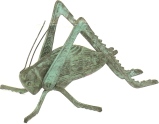Don’t Leave the Insects Alone!


A couple of weeks back I wrote about field recordings, and mentioned Chris Watson’s objection to Mira Calix piece for electronics and insect sounds, Le Jardin d’Barbican. Why have the music when you already have the insect voices, was Watson’s point. Leave the insects alone. Which is more the opinion of a field-recording professional than an original member of Cabaret Voltaire, although Watson is both of these things. Now, I like Chris Watson. I think he’s a terrific sound recordist, and if he ever wants to come and stick one of his microphones in my tank of tiger barbs, he’d be more than welcome. However, insects and electronic sounds go rather well together, actually.
During the 1970s, Brian Eno became very proficient at making his synthesizer do imitations of all sorts of different insect noises. His ambient work makes use of fabricated insect-filled soundscapes in synthesis with actual recordings of insects and frogs; for the recent Plague Songs compilation on 4AD, for which various artists made a piece about one of the ten Biblical plagues, Eno contributed a track called Flies which also uses insect atmospheres. But apart from the customary Eno-atmospheres, it’s the insect-machines that take lead parts that really get me. On African Night Flight, from David Bowie’s Lodger album, Eno makes a sinister kind of insect pop, generating weirdly expressive synthetic clicks and squawks whilst Bowie (whose voice is always at its most moving when he himself is most detached, which is something of a surprise victory for Plastic Soul) does proto-white-rapping and sings in a made-up “African” language.
In J.-K. Huysmans’s À rebours, the best book ever written by anyone, the effete dandy-hero Des Esseintes is an individual cultural synthesizer par excellence who retreats from society to a home furnished with the meticulousness of a true pervert. Here he indulges each of the senses systematically, with artwork by Moreau and Rops, a liqueur-filled taste-organ for which synaesthetic taste-symphonies are composed, and perfume to serve as olfactory furniture. Now, as a sound-generator, what does Des Esseintes install in his home, but a solitary cricket, left to chirp alone in a cage, triggering memories of an unhappy childhood. This cricket, in fact, is placed above his bed, in the hope that the memories of his mother will ingnite in him sufficient lust to “drain the cup of sensuality to its last and bitterest dregs”, and finish the job with “the woman he was mechanically caressing”. Consider this for a moment the next time you hear an insect sing.


A century after Huysmans, Des Esseintes finds a synthesizer-sympathiser in the form of Fad Gadget, Daniel Miller’s first (and finest) new synth-art acquisition for Mute Records, and a performer and producer of pop who had lived and learned through Bowie and Eno. Miller himself contributed pained electro-insect noises to Back To Nature, which was Fad Gadget’s first recording and was made in a cupboard. Fad Gadget, soon to name himself King of the Flies, makes all the right noises about getting back to nature by turning his back to nature, which is a hundred years but a hundred miles away from Des Esseintes in À rebours, which you will find in the English translation as Against Nature. Find Fad Gadget filed very close to Chris Watson’s early work with Cabaret Voltaire in the great catalogue of all that’s good and right.
And with that I end because nature calls, on a mobile phone, from a digital garden, trying to get a record contract.
i’m so glad you mentioned bowie’s african nightflight. tis one of the finest avant garde pop songs of all time. the album lodger is one of my favorites & seems to be somewhat overlooked. it has some of his most creepy crooning on it.
Yes, you! I’m looking forward to listening to what you have for us tonight.
Very nice article. Death is everywhere, there are flies on the windscreen.
Tod Dockstader And David Lee Myers’ “The Pond” is a fascinating record, a collaboration between a field recordist and an electronic composer. Starting from field recordings of a pond made by Myers, Dockstader painstakingly reconstructed all the insect sounds (and bird sounds) with synthetics. It’s a very weird and comforting record: plastic nature, very A Rebours!
crickets have to be breeded so catchem and sell them iam a fan of bugs and i think if you know anyone that kills insects or bug then trie to get them to STOP please because they wont harm you.
I agree.
Black widows, scorpions, fire ants, wasps are all potentially harmful/lethal. Mind you I don’t go out seeking to kill them like some sort of insect bounty hunter… but if one was in my bed or house I would have an old fashioned freak-out.
Wasps don’t mean no bother. Ants are brilliant. Do you know of any good ant colonies round here that I could see?
I want to know what Joe and Dominic think to all this.
I BELIEVE IN BUGS.
There might be one at the Ontario Science Center… perhaps we should go sometime? Or you could just pour some sticky stuff like maple syrup on the sidewalk this summer and the colony will come to you!
Thanks!,